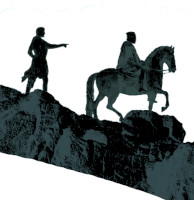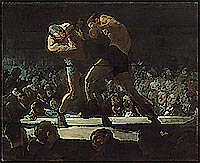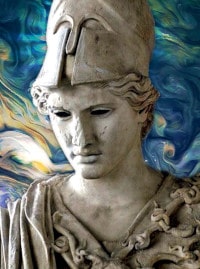Reading from The Wisdom of the Native Americans, compiled by Ken Nerburn, pages 82-133
1999, MJF Books, NY, 216 pages
Many Lightnings was a warrior of the Santee Dakota, who lived as a captive of the white men in their eastern cities. When he returned to his people he sent his don, Ohiyesa, to the east to attend school and learn the ways of the Whiteman, as he was certain that Indian culture could not survive in the face of this threat.
Ohiyesa took the white name Charles Alexander Eastman, attended Dartmouth college, later worked as a doctor, and, as a respectable New Englander, became involved in the scouting movement, which he recognized as a method of preserving aspects of [masculine] native culture through white society, which was obviously the only society that was going to make it. This seems strange to our view—teaching the sons of the people who extinguished your people and outlawed your way of life—but only because we look upon Ohiyesa from the vantage of a materialistic [i.e. maternal, feminine] emasculated society. His was the ultimate masculine act—the act of transcendence—of which we remain necessarily ignorant rooted in our materialistic construct.
A good recent example of this would be the number of top flight black boxers of the last generation, who have become the mentors of white Eastern European men who have taken up the art that was regarded as quintessentially Africa American for nearly a century, which is an entire age in boxing terms, where lifetimes are limited to 20 years.
In The Soul of An Indian Ohiyesa professes a sort of deism that seems to have been shared by men as diverse as Aristotle, and Charles Darwin, though it would be derided by modern theologians as lacking a deistic pedigree. The gist of this notion of the human soul seems very similar to this recent comment by power engineer Jim Fry after a pretty bleak monologue on the fragility of our nuclear infrastructure,
“Handling this resolution without falling into a depressive state and stance is my greatest challenge, which I combat by resolving that the best I may do is be generally kind, helpful and giving to those I care about and encounter. None of us know for certain if we have more lives or consciousness when we pass from this story, but I do get a sense that we may be continually refined across life and that there may be more to come, beyond, so (if so) why waste the course we're in, no matter how arduous it may be at times?”
After reading Jim’s comment I went directly to The Soul of An Indian and consulted the old Dakota, “Certainly we never doubt the immortal nature of the human soul or spirit, but neither do we care to speculate upon its probable state or condition in a future life.”
Ohiyesa goes onto further commentary on the difference between primal and civilized notions of transcendence:
“The idea of a ‘happy hunting ground’ is modern, and probably borrowed from or invented by the white man.”
“…nearness to nature…keeps the spirit sensitive to impressions not commonly felt, and in touch with the unseen powers.”
“Our transition from our natural life to the artificial life of civilization has resulted in great spiritual and moral loss.”
“The two great ‘civilizers’ after all, were whiskey and gunpowder, and from the hour we accepted these we had in reality sold our birthright, and all unconsciously consented to our own ruin.”
“Any pretty pebble was valuable to me then; every growing tree an object of reverence. Now I worship with the white man before a painted landscape whose value is estimated in dollars!”
“When I reduce civilization to its basic terms, it becomes a system of life based on trade…Is there not something worthy or perpetuation in our Indian spirit…”
The following is an incomplete index of links to literary and video reviews that touch on the statement of Mister Fry I read before going away for a family weekend, and a conversation I had with my cousin John, about his getting involved with the Boy Scout movement as a way of escaping the cultural rot he sees assailing his sons, such as watching a teenager shoot heroin on the parking lot of an upscale shopping center.
The Silence Of Men There is an entire series of videos available at this YouTube link
‘The Gun That Killed Tecumseh’ Muzzleloader magazine has a wealth of information on primitive woodcraft and early American history. The paintings of Native Americans that grace their covers are phenomenal.
And the print book Incubus of Your Sacred Emasculation at this link











My heart of hearts has always told that this way of life is bogus. Thanks for the article. Ishmael